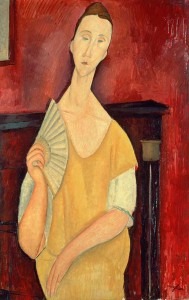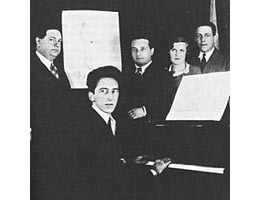
Modigliani: La Femme à l’éventail (1915)
The French ballet teacher, Jeanne Dubost, was the subject of a children’s ballet written in collaboration in 1927. She sent ten composer friends a leaf from her fan, and requested that each write a short piece for her children students. And so the 10 friends, Maurice Ravel, Pierre-Octave Ferroud, Jacques Ibert, Roland-Manuel, Marcel Delannoy, Albert Roussel, Darius Milhaud, Francis Poulenc, Georges Auric, and Florent Schmidt, did as she requested. Of the composers, all are familiar names today except for Ferroud and Delannoy.
The work was given its debut in a private performance with Ravel at the piano and then was taken to the Paris Opéra in 1929. Each of the sections is a dance type: waltzes, sarabandes, and the like.
We open with Ravel’s Fanfare, which as Roland-Manuel described it, is “a Lilliputian flourish, which begins like the buzzing of troops of insects and rises to its climax in the style of Götterdämmerung”. It was encored at the end of the première performance.
Ravel: L’Éventail de Jeanne: Fanfare (Orchestre National des Pays de la Loire; John Axelrod, cond.)
Ferroud’s March seems to pay homage to a contemporary composer who is not represented among the 10: Stravinsky. The minimal scoring, the bright use of rhythm, the focused orchestration all call Stravinsky to mind.
Ferroud: L’Éventail de Jeanne: Marche
Ibert’s Waltz isn’t the oddly macabre La Valse that his teacher Ravel had written in 1920, but is very much one for children: light, humorous, and full of fun. Ibert plays with some of the stock waltz ideas that would have come straight from Strauss, but this is very much a French frippery.
Ibert: L’Éventail de Jeanne: Valse
And so it goes on: we have Roland-Manuel’s Canarie, a dance from the Renaissance, and Delannoy’s Bourrée, another sixteenth-century dance that is most familiar from the cello suites of Bach. Roussel contributed a Sarabande, which takes us into a Spanish triple time. This is our first slow movement and provides an ideal central point of reflection on all the dancing that’s been whirling around us.
Roussel: L’Éventail de Jeanne: Sarabande
Three members of Les Six, Milhaud, Poulenc, and Auric, bring us the next three dances: a Polka, a Pastourelle, and a Rondeau. Milhaud’s Polka is a perfect children’s dance but he was so annoyed at finally making his debut at the Paris Opéra with such a minor piece that he refused to attend, missing what was said to be 10-year-old future star ballerina Tamara Toumanova’s great success.
Milhaud: L’Éventail de Jeanne: Polka, Op. 95
Probably the best known of the pieces from the entire ballet is Poulenc’s Pastourelle, mainly because it was included in so many piano books in Poulenc’s own transcription for piano. The Pastourelle was a medieval song, usually about shepherds meeting shepherdesses and so Poulenc captures that rural flavour.
Poulenc: L’Éventail de Jeanne: Pastourelle
Georges Auric’s Rondeau, or, more properly, a rondo in ABACADA form, uses contrasting dance forms: A is a Spanish Dance, B is more delicate piece, C is a gallop, and D is a sombre waltz.
Auric: L’Éventail de Jeanne: Rondeau
The whole evening’s extravaganza closes oddly for such an innovative evening of music. The longest work of the production was Florent Schmitt’s closing Kermesse-Valse, which he had written some 20 years earlier. Yet, it does provide a truly grand ending to a great evening of ballet.
Schmitt: L’Éventail de Jeanne: Kermesse-Valse

